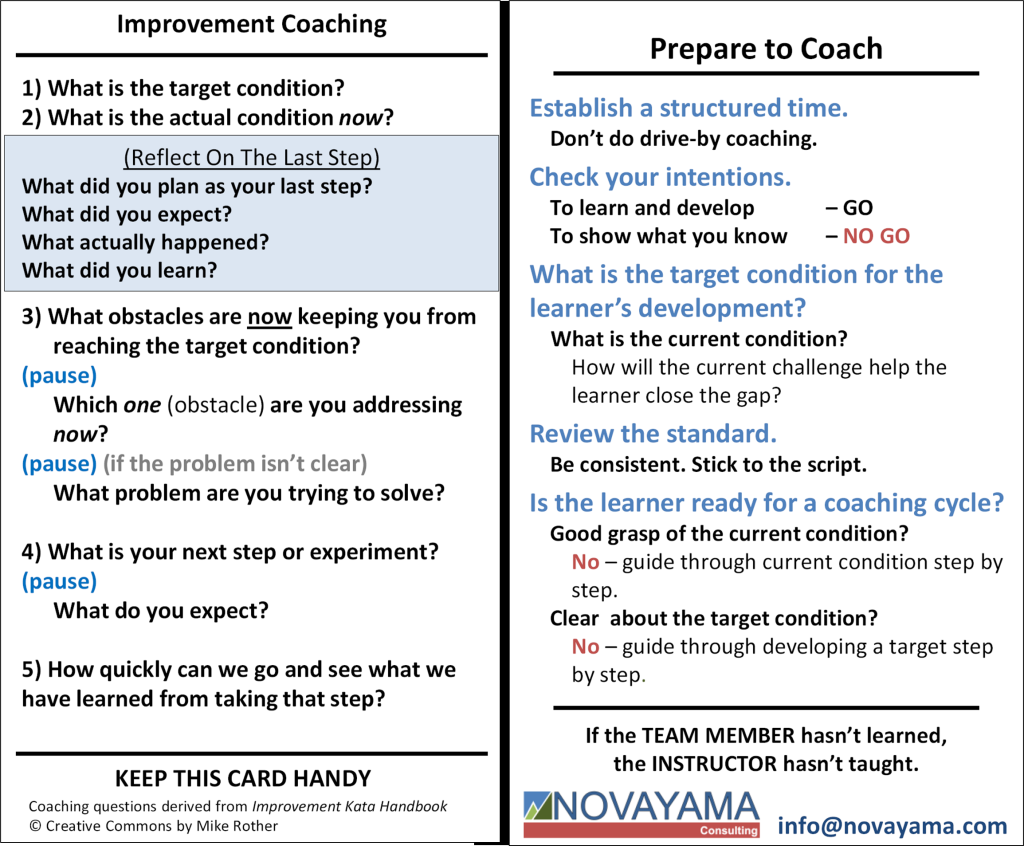The client organization was working to incorporate the Toyota Kata mindset – scientific thinking / systematic problem solving – into their daily routines. This was early on in my journey as well, we were all learning.
The company had a structure for how they wanted to go about it. My role was to advise, coach, and be “the expert” in the room. After some initial awareness training and exercises, they set up storyboards and started trying to apply the concepts to actual challenges.
Learning groups of three would practice by doing round-robin coaching, with one in the role of the learner, one in the role of the coach, and one in the role of the 2nd coach.
I would spend about a week a month working with them to help them stay between the guard rails. As long as they were serious about their reflections, and kept the mindset that they were all working to learn something unfamiliar, it worked pretty well.
Then something really cool happened.
One of the managers related that he had used the Coaching Kata to work with one of his employees who was on a PIP.
For those who don’t know, PIP stands for “Performance Improvement Program” and, bluntly, is usually a pro-forma process that ends with the person being fired. The idea is that they are told what changes they must make in their behavior and given a deadline to make them. There are lots of ways to do this in ways that the victim, I mean subject, simply cannot succeed. In general, I consider the entire process disingenuous.
But that’s not what happened in this case. Rather than laying out a checklist of criteria, the manager started coaching.
He took his employee through “Grasping the Current Condition” and had him describe the behaviors(s) that were getting him into trouble. The employee was asked to begin keeping track of those things during his day.
Rather than telling him what must be changed, the manager asked the employee about a Target Condition: What are you working on now? What obstacles do you see that are in the way?
They met every day and reviewed what the employee intended to do, what he expected, what actually happened, and what he learned in the process. Every. Single. Day.
At the end of the 90 day process the guy had changed – to the point of being a totally different person at work. He kept his job, and became a real contributor to the team.
What really impressed me was that this was a novice coach, he had been exposed to Toyota Kata a few months before. And, honestly, it was a low-risk situation for practice (at least for the manager) – they had already written this employee off. But this manager, instead, made a commitment to do the hard work beyond just being critical and documenting every transgression. He had his employee doing the documenting and reflecting as he went.
What Was Different?
One of the ways we distinguish technical work from adaptive work is asking, “Who’s job is it?” In other words, who has to do the work?
While we are fond of saying things like, “If the student hasn’t learned, the teacher hasn’t taught,” the truth is that it is only the “student” who can learn, and learning requires an intrinsic motivation to do so. If the motivation isn’t intrinsic you may gain compliance, but that is the best you are going to do.
The coach in the story above created an environment where his Team Member was the one who had to understand the current condition, had to make decisions about what he wanted to change, and had to decide how he was going to try to make those changes.
It wasn’t a case of telling him what to do. There is a big difference between being told, “You need to…” and saying out loud, “I want to…” The coach gave his team member the opportunity to turn that “need to” into a “want to” and then provided structure for doing it.
At the same time, the coach was willing to put in the work to hold that structure in a way that created safe space for the team member to reflect on his own behavior and learn.
This Is the Improvement Kata
And finally – my title is misleading. This is the Improvement Kata. The only difference is in context. Rather than working to improve a process as an outside observer, the Team Member was working to improve the process of his own behavior. The fundamental steps are exactly the same:
- Agree on the overall challenge.
- Reach agreement on the current condition, including cause and effect.
- Establish a concrete goal (Target Condition) and identify obstacles.
- Engage in experiments, with discrete learning and feedback, to overcome the obstacles.
Have you had cases where you have used a similar process to help someone through real change? I’d love to hear about them.
(Click on the coaching cards below to download your own if you want.)

One Reply to “Using the Coaching Kata Outside of the Improvement Kata”